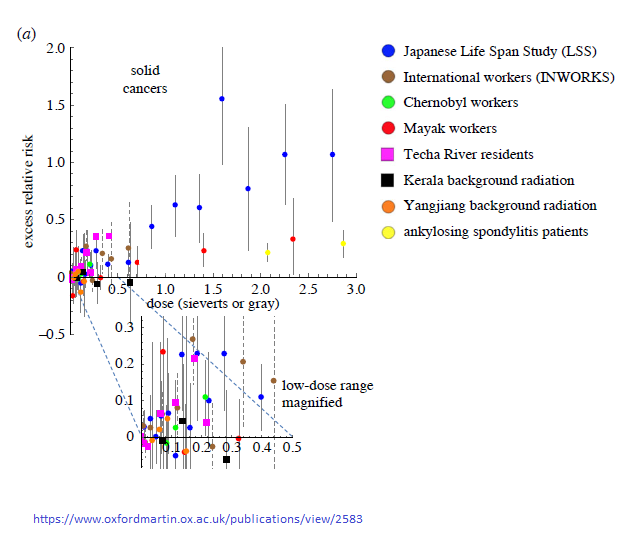Linear No Threshold Hypothesis (LNT)
Introduction
We know that radiation in large, quick doses causes measurable harm because of the large number of people that have been exposed to such doses and the symptoms they have shown. With lower doses of radiation, certainly doses below 100 mSv, the evidence of harm is much less clear.

Over the years since the early 20th century a lot of work has been performed comparing groups of people who have been exposed to non-fatal doses of radiation to similar groups who have not been exposed and comparing the health outcomes for the two groups. This work is not without its challenges. A summary of some of the data collected is presented in the diagram to the left. From A restatement of the natural science evidence base concerning the health effects of low-level ionizing radiation (Ref.). This shows that when you include error bars to denote the uncertainty it looks as though there is a relationship between dose and probability of effect, but it is not possible to say with confidence that there is not a threshold below which radiation does you no harm. Indeed some have argued that low doses of radiation may be good for you (Radiation hormesis).
Radiation hormesis: The theory of radiation hormesis states that low doses of ionising radiation are not only harmless, but they have beneficial effects by stimulating the immune system and repair mechanisms. The theory of radiation hormesis is in conflict with the LNT (Linear No-Threshold) hypothesis.
The linear no-threshold hypothesis (LNT) is “A dose-response model which is based on the assumption that, in the low dose range, radiation doses greater than zero will increase the risk of excess cancer and/or heritable disease in a simple proportionate manner” (ICRP).
Because we accept the linear no-threshold hypothesis as a prudent assumption, we also assume that there is no “safe” dose of radiation. Each micro-sievert (μSv) is as likely to induce a cancer as the next. So the next μSv of radiation is as dangerous to you as the first whether or not you’ve previously had a dose of 10 μSv or 150 mSv.
The upshot of this is that health physicists (radiological protection professionals) try to keep all doses as low as reasonably practical, they do not talk about a “safe” dose and they do not panic when discussing low doses. This presents difficulties when the public ask, “is it safe?” when discussing levels of radiation exposure.